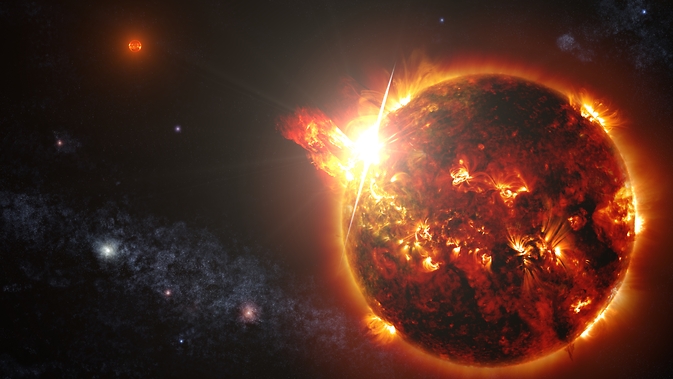'Just produced' in the title is cosmologically speaking - the "superflare" came from one of the stars in a close binary system known as DG Canum Venaticorum (DG CVn), which is 60 light-years away. Both stars are dim red dwarfs with masses and sizes about one-third of our sun's. They orbit each other at about three times Earth's average distance from the sun, which is too close for Swift to determine which star erupted.
At its peak, the flare reached temperatures of 360 million degrees Fahrenheit (200 million degrees Celsius), more than 12 times hotter than the center of the sun. The star's brightness in visible and ultraviolet light, measured both by ground-based observatories and Swift's Optical/Ultraviolet Telescope, rose by 10 and 100 times, respectively. The initial flare's X-ray output, as measured by Swift's X-Ray Telescope, puts even the most intense solar activity recorded to shame.

Artistic rendering of DG CVn. Credit: NASA's Goddard Space Flight Center/S. Wiessinger
"This system is poorly studied because it wasn't on our watch list of stars capable of producing large flares," said Rachel Osten, an astronomer at the Space Telescope Science Institute in Baltimore and a deputy project scientist for NASA's James Webb Space Telescope, now under construction. "We had no idea DG CVn had this in it."
Most of the stars lying within about 100 light-years of the solar system are, like the sun, middle-aged. But a thousand or so young red dwarfs born elsewhere drift through this region, and these stars give astronomers their best opportunity for detailed study of the high-energy activity that typically accompanies stellar youth. Astronomers estimate DG CVn was born about 30 million years ago, which makes it less than 0.7 percent the age of the solar system.
Stars erupt with flares for the same reason the sun does. Around active regions of the star's atmosphere, magnetic fields become twisted and distorted. Much like winding up a rubber band, these allow the fields to accumulate energy. Eventually a process called magnetic reconnection destabilizes the fields, resulting in the explosive release of the stored energy we see as a flare. The outburst emits radiation across the electromagnetic spectrum, from radio waves to visible, ultraviolet and X-ray light.
At 5:07 p.m. EDT on April 23, the rising tide of X-rays from DG CVn's superflare triggered Swift's Burst Alert Telescope (BAT). Within several seconds of detecting a strong burst of radiation, the BAT calculates an initial position, decides whether the activity merits investigation by other instruments and, if so, sends the position to the spacecraft. In this case, Swift turned to observe the source in greater detail, and, at the same time, notified astronomers around the globe that a powerful outburst was in progress.
DG CVn. Credit: NASA's Goddard Space Flight Center/S. Wiessinger
"For about three minutes after the BAT trigger, the superflare's X-ray brightness was greater than the combined luminosity of both stars at all wavelengths under normal conditions," noted Goddard's Adam Kowalski, who is leading a detailed study on the event. "Flares this large from red dwarfs are exceedingly rare."
Source: NASA





Comments